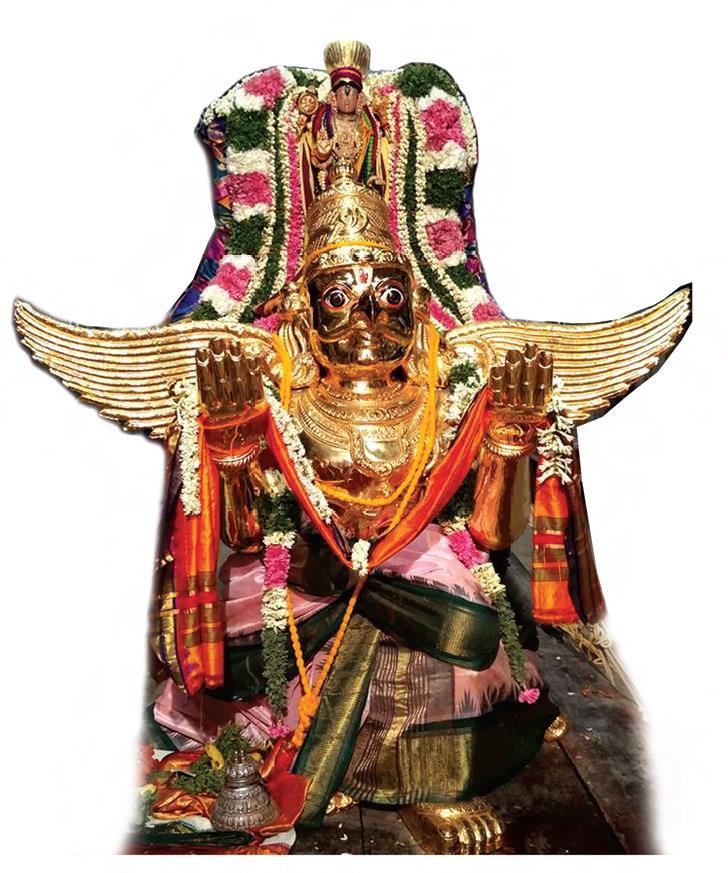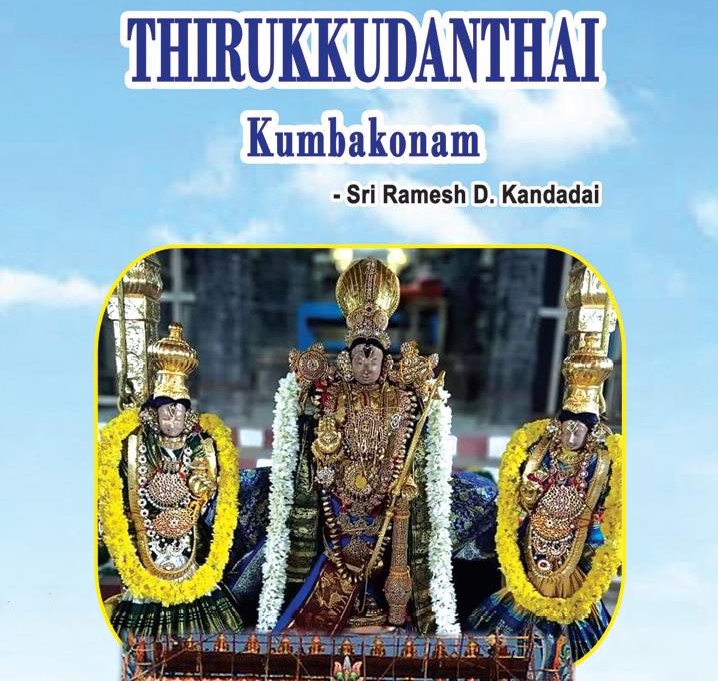Thirukkudanthai – One of 108 Divya Desams
The town of Kumbakonam or Thirukkudanthai is renowned as a center for Vaishnavaite and Saivite culture and many temples of both faiths dot the landscape. Historically it has been around since the early Chola period. Since sangham period it has been ruled by Early, mid, and later Cholas, Pandya, Vijayanagar, and Nayaks.
It has been known for long as a center of Hindu cultural learning. We will focus only on the Srivaishnavaite aspect of Thirukkudanthai with particular emphasis on Sri Sarangapani temple. Many regard the shrine as one of the most important Srivaishnavaite temples along with Srirangam, Tirupati, Kanchipuram, and Thirumaliruncholai.
Location
About 85km due east of Srirangam along the southern bank of the Kaveri River, is Kumbakonam or Thirukkudanthai in Tamil Nadu in South India.
Sthalapuranam
The Sage Brighu went to Sri Narayana’s abode in Ksheera sagar to test the Lord’s patience. Unhappy with the attention being not given to him, Brighu kicked the Lord in his chest. Mahalakshmi who always resides the Lord’s left chest got angry (because Sri Narayana did not chastise Brighu for kicking where she resides) and left Sri Vaikunta. Vishnu followed her to earth and but she remained angry with him. It is said that he lived below ground as Patala Srinivasa till her anger cooled down.
Then sage Brighu apologized and was reborn as Hemarishi who prayed that Mahalakshmi should be born as his daughter. Mahalakshmi emerged from the Potramarai tank amidst lotuses as the daughter of Hemarishi. Hence the name Kamalavalli.
Vaidheeka vimana
The Lord, in a reclining posture, descended from Sri Vaikunta in a chariot drawn by horses and elephants. That is why the sanctum of Sri Araavamudha (ever-sweet nectar) is shaped in the form of a chariot drawn by horses and elephants. There are two entrances to the sanctum – Dakshinayana and Utharayana entrances. The vimana is called Vaidheeka vimana.
The temple pond is Hemavalli Pushkarani. It is said that the Vaidheeka Vimana and Pranavakruthi Vimana are two parts of a whole. The Lord arrived under Vaidheeka Vimana on Makara Sankranthi day to wed Kamalavalli.

Special Features
When Thirumazhisai Alwar reached this temple during his wanderings, he is said to have asked the Lord if after walking so much in Rama avataar and measuring it as Vamana, after picking up mother earth in Varaha avataram, is he shaken and tired? Can he not rise and receive the Alwar who is his guest? On hearing this Sri Araavamudha got ready to rise.
Shaken by the Kindness of the Lord in listening to his devotee, Thirumazhisai Alwar requests him…please remain as you are. The Lord freezes in the half-arisen posture. It is known as udhdhana sayi in Sanskrit and Sarangapani temple is the only place in the world where the Lord can be seen in this posture.
One version of the story goes that Sri Nathamuni while worshipping Sri Araavamudha heard a few devotees recite some Tamil pasurams ending with the line “These ten of the thousand that Satagopa wrote”. When he enquired, he was told that they knew no more and maybe he should enquire in Alwar Thirunagari with the descendants of Madurakavi Alwar. Thus began the search which ended with the grace of Nammalwar in reestablishing the four thousand pasurams in current use. The Lord is referred to as ‘Sri Araamudhalwan’.
This temple has no Sorga Vaasal as one worships the Lord in his chariot arriving from Sri Vaikunta. Any darshan of the Lord here results in salvation.
Since this is the birthplace of Kamalavalli, the Lord is considered to be the in-house son-in-law! The priority of worship goes to the mother of the Universe whose natal home is this.
The main deity (Sri Aravamudan) and processional deity (Sri Sarangapani) are treated with equal regard here. Consequently, the temple is referred to as Ubhaya Pradhana Divya Desa. A devotee of the Lord who served him died on Diwali day issueless. Before death, he requested the Lord to arrange for someone to perform his last rites.
To this day, every Diwali day the Lord performs (through the priest or Archaka) the annual shradh ceremony in strict privacy at the sanctum.
Mangalasasanam
There are 52 pasurams by seven Alwars about this temple. Amongst the 108 Divya Desam, this temple is the sixth most sung-about temple.
In Irandaam Thiruvandadhi, Bhoothatalwar (2251) says the Lord resides in many places including Thirukkudanthai. In another pasuram (2278) he says the Lord of Nityasuris has taken up residence in Thirukkudandhai on the bed of many hooded Adhisesha.
In Mundraam Thiruandadhi, Pey Alwar, says (2311) that places such as Ksheera Sagar, Paramapadham, Vengadam, and Thirukkudanthai are the places where it pleases the Lord to reside. In another pasuram (2343) he calls Thirukkudanthai the center of the world and says this is where he who accepted water from Mahabali Chakravarthy in the gifting ritual lives.
In Naanmugan Thiruandadhi, Thirumazhisai Alwar (2417) lists the shrines such as Thirukkudanthai where the Lord is resting on Adhisesha and says he rests purely to enter the hearts of his devotees. In Thiruchandaviruttam, he refers to the Lord as the one who is resting (807) in Thirukkudanthai after severing the ten heads of Ravana. He refers to incidents in the Rama avatar and Krishna avatar in the next few pasurams (807-812) and ends by asking the Lord after all this walking in the Rama avatar, after picking Bhumi Devi in the Varaha avatar, are you so tired that you are unable to rise to receive me, your guest.
Perialwar in Perialwar Thirumozhi (188) refers to the Lord of Thirukudanthai as he who split the chest of Hiranyakasipu into two.
Andal in her Natchiyar Thirumozhi (628) claims to have fallen under the spell of the Lord resting on a tender banyan leaf. She refers to him as he who is resting in Thirukkudanthai and asks that his basil leaves be brought over and applied to her hair.
Nammalwar in his Thiruvaimozhi (3194-3203) refers to Aramudhan as the sweet-tasting nectar that has taken residence in his heart. He also refers to him as he who has taken up residence in Thirukkudanthai.
Thirumangai Alwar in Thiruvezhukuttrirukkai, (2672) (inscribed on the wall near the entrance to the temple) towards the end refers to Thirukkudanthai as the place where the brahmins utter veda-suktas in the presence of the lord who rests on Adhisesha.
Finally, the best reference to the Lord of Thirukkudanthai is by Nammalwar, the one pasuram (amongst ten) (3203) which centuries later led to the revival of Nalayira Divya Prabandham. Nammalwar welcomes the Lord into his heart as the handsome one who is named and is Araamudham and being the sweet nectar, he fills his devotees with sweetness. He is also one who will cut the bond to samsara and rule over the devotee. The name of the Lord says it all – Aaraa Amudhan!! Only a sample of fifty-four pasurams is presented here.
Om Namo Narayana

